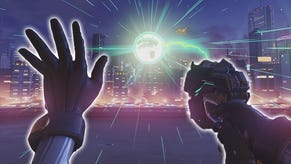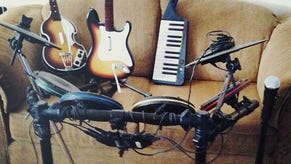To all those about to ROCK...
We salute Guitar Hero. With help from Harmonix's Luke Jacobs.
"It's usually difficult to discern creative primacy in a situation like this," says Luke Jacobs, QA lead on Guitar Hero, Harmonix's guitar-powered rhythm-response PS2 game. "However in this case it's easy, it was me."
"We were sitting around trying to figure out cool things to do with the peripheral and I said 'Hey guys, let's... I dunno, do something crazy like... like swing the guitar handle skyward!' We were all really excited because it was such a new idea. It's amazing to think that in all the years of Rock, no one has ever pulled that little manoeuvre. No one. Ever. All me."
Admittedly, when we asked Jacobs how Harmonix came up with the idea of activating Star Power - Guitar Hero's 'special move', which increases the number of points you get for playing the correct notes on your giant Gibson SG guitar peripheral - we were actually trying to find out what inspired them to link the physical action to the game function. But given how much we love Guitar Hero, we'll let him off for treating us like a roadie turning up with the wrong brand of foie gras.
Guitar Hero, due out in the UK this Friday, April 7th, is what Harmonix calls a "beatmatching" game. As familiar music from the likes of Bowie, Hendrix and Deep Purple plays, a series of circular icons move down an on-screen fret board through a line of circles, and it's your job to "play" the corresponding "notes" as they do so. Harmonix's previous stabs at beatmatching, FreQuency and Amplitude, were widely acclaimed as some of the most addictive, instinctive rhythm-response games of their generation. "FreQuency and Amplitude proved something that Harmonix has always held as one of its main tenets. And that is 'making music is fun'," says Jacobs. He's not wrong - both games were fun.
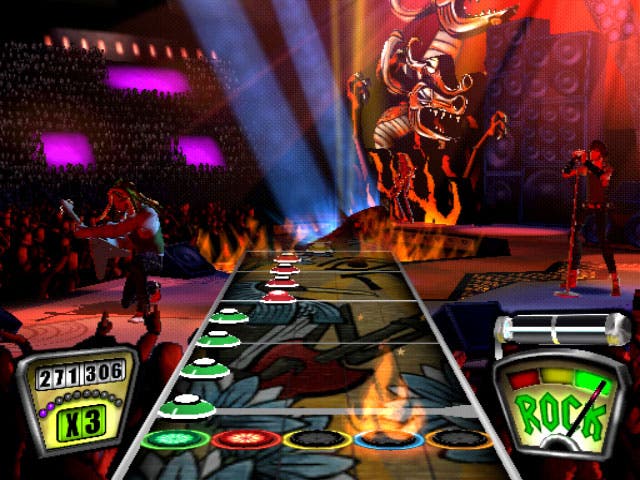
But with Guitar Hero, Harmonix had the idea of doing an actual musical instrument peripheral - the Gibson guitar plugs into the PS2 controller port and sports five coloured fret buttons, an up-down "string" that you can pluck and strum, and a whammy bar for bending the notes you play. Start and Select buttons masquerade as volume controls, and then there's Jacobs' amazing, startling invention, the star power-activating switch in the neck, which shifts you into the world of big points when you angle the neck skywards.
The thing is, whereas FreQuency and Amplitude were an awesome pleasure for a fine-fingered minority, Guitar Hero just might be the most mainstream hardcore game ever made.
"I think the controller is a lot more accessible to your average gamer because it's shaped like a guitar and most players already have a set of expectations about the way it's going to work," says Jacobs. "That was one of the challenges we ran into with AntiGrav [a Harmonix game controlled with the EyeToy camera]. Not only did players have to learn how to play the game, they had to learn how to work the controller as well."
And whereas FreQuency and Amplitude were trying to give people the sense that they were making music, it's much easier here. "With Guitar Hero, when we're actually able to put something like an instrument in the player's hands, I think the illusion is made that much more compelling," Jacobs notes.
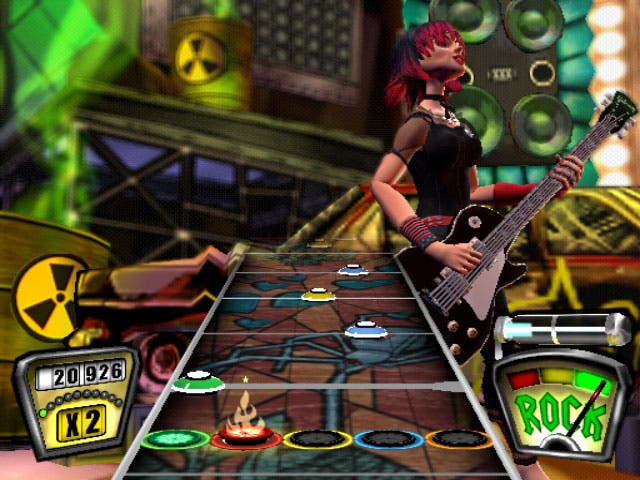
As with the previous beatmatchers, the idea was to create a game where at a basic level it was possible for the player to feel like they were playing the music, but which could extend to accommodate more skilled players with lightning fingers. The goal was to reach the point where players found themselves in a kind of "zone" where physical reactions seem to come faster than conscious ones, as they often did for those addicted to FreQ and Amp, Jacobs confirms.
"Introducing Hammer ons and pull offs into the game went a long way towards making the game really play like a guitar," he says. "Because they make certain dense passages easier to play, it really let us get as close as possible to a 1:1 note to gem ratio on expert difficulty." Which is what it's all about.
"Also, one of our guys, Izzy Maxwell, has a Mohawk and I think that helps."
Getting to that stage (the realisation of expert guitar-playing, not the Mohawk) was an interesting journey, but it didn't take long to get going - indeed, a post-mortem in Game Developer magazine claimed the whole game only took nine months from start to finish. "It may sound funny, but the first [game] prototype we got running seemed like a major breakthrough. It was just a bunch of pink rectangles flying across the screen to the guitar track of a song we used in Amplitude. All you had to do was press the X button at the right time. There wasn't much to it, but it was already fun. That helps a lot, when you're in the first weeks of a project and you realise that the gameplay is already solid."
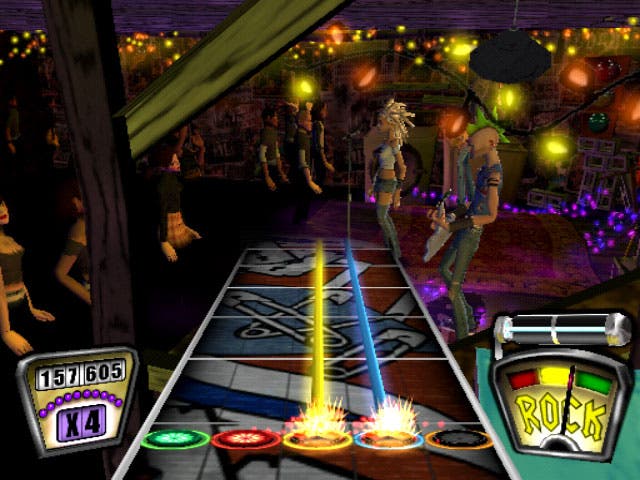
Then came the guitar itself. "[Publisher] Red Octane created the peripheral. We had a lot of input, and as we developed the game we went through a lot of prototypes with slightly different features. There was a lot of back and forth that eventually resulted in the plastic goodness you hold in your hands now."
Which is very well, but how does that Star Power neck-swinging move actually work, after all that? "It used to be a mercury switch, but unfortunately it seems there's some law about importing or exporting transition metals. Go figure. In the end we went with a combination of ball bearings and gravity." It's a serious thing, too, and makes a big difference. That said, "we put it in the game because we had to. It's 100 per cent Rock. If we hadn't added it, we would have had to call the game Guitar Loser, and it wouldn't have done nearly as well."
Despite the game's relatively short gestation, there was still time to throw out ideas along the way. At GDC last month, two of the Harmonix guys introduced a talk about experimental game design by discussing a mode, eventually dropped from the game, in which you actually played the guitar as a guitar, rather than simply matching beats. Apparently it didn't make it in for a few reasons - most notably that all the samples wouldn't have made it onto the PS2 disc, but also because it was much easier to sound like you were beating a cat to death with a screaming child whilst listening to Melt Banana than anything else. Other ideas came and went too. "For a while we were toying with the idea of a wah-wah peddle accessory. But in the end it turned out to be too much buck, not enough bang."
A lot of post-release chatter in the US, and amongst those of us over here who imported the game, has focused on the song line-up. "We had a long list of songs we wanted, and then that got pared down into a list of songs we could get, and then came the painful process of deciding which of those songs couldn't fit in the schedule," says Jacobs. "There are a lot of different things we look for, and I think that shows by the variety of songs we shipped with. Some songs get in because you can't not have them, others get in because of a particular riff that's interesting to play. Of course, the biggest question is 'does this song rock?'"
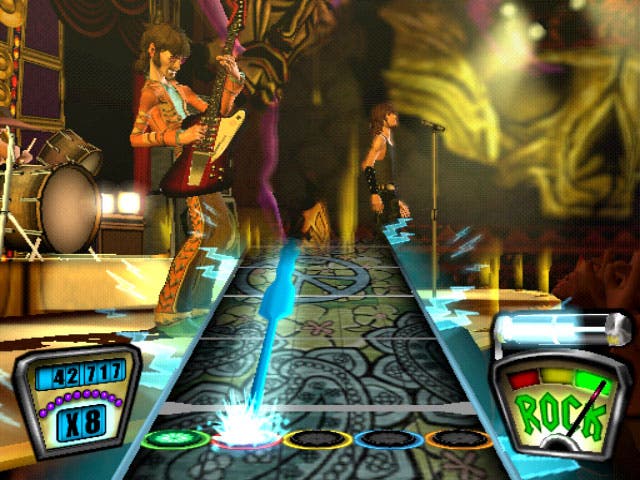
That said, while there's an impressive number of tracks on there and some definite classics from Boston, Joan Jett, Ozzy, et al, and some solid contemporary stuff like Audioslave and even Franz Ferdinand, it didn't take too long for people - even those soloing its praises - to start asking about the absentees. Where's Led Zeppelin, for instance? "You can't always get what you want," says Jacobs. "Sometimes the price is prohibitive, sometimes the artist doesn't want their song associated with a videogame and sometimes they just don't return our calls. You know who you are."
But, "if you're wondering why a certain song isn't in the game, you can be sure it wasn't from lack of trying."
With the game's critical success already in the bag (we loved the American release when we had to pay £100 for it, so you can imagine how we'd feel about the UK release, which will go for half that), there's been talk in the press about the possibility of follow-ups - with RedOctane CEO Kelly Sumner suggesting there may be "five or six" titles by the middle of 2007, with a 40-track-plus direct sequel already on the way and the possibility of genre spin-offs and everything. So surely all this buzz is bound to be good for the developer's chance of attracting interest from the artists rather than having to convince them? "I don't know that anyone has actually come to us, but I imagine the critical success won't hurt when we go looking for artists to work with," says Jacobs.
More importantly, those of you who have managed to avoid buying a PS2 in the last six years (congratulations, by the way) will be wondering what chance there is of getting your hands on Guitar Hero for an Xbox, or any other console. Was it ever the plan to do more than one version? "Did we originally plan to go multiformat? No, we didn't really have those kind of plans. I think it's pretty risky to launch a brand new peripheral on multiple consoles." That said, "I think the more hands we can get Guitar Hero into the better."
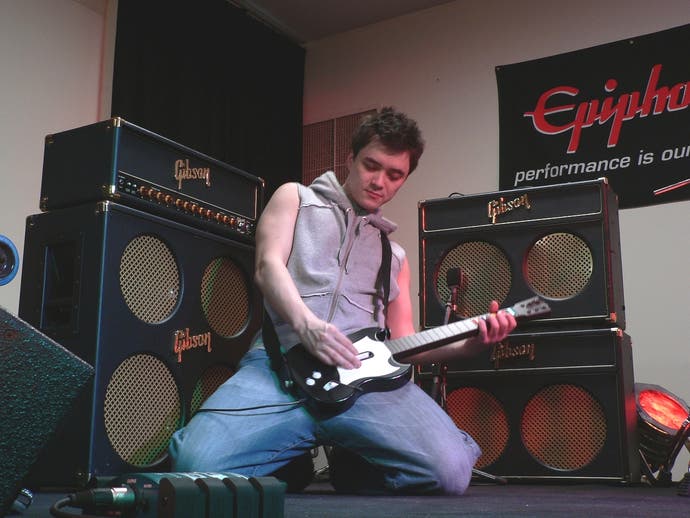
What about Xbox 360, we asked, with its Marketplace system for downloadable content? Surely that's ideal? "The Xbox 360 Live service offers developers a lot of interesting possibilities for additional content. I think you have to assume that any games that come on out on the next-gen consoles are going to make use of the online capabilities. Unless they're lame." Speaking before GDC, we didn't have time to factor in the PS3's potential for similar downloadable extras, but with Sony already planning to adopt this approach for its Singstar titles, it's clearly something we could see happen one day.
For now though, it's all about the first game, due out on Friday, and one of our favourite bits is watching people playing up to the crowd of friends massed around the TV during a performance. That said, you might want to avoid swinging the guitar around your neck - we tried that last week and managed to nearly strangle ourselves and knock the PS2 on the floor. Rock and roll and CRAP CRAP DOES IT STILL WORK. Fortunately the guitar's fine - but surely the Harmonix lot have managed to wreck a few?
"Oh my yes."
"Before we had any prototypes we were working with these ten-year-old peripherals for a PSX game. We went through those pretty quickly. I believe the record for 'fastest kill of a practice guitar' was one day. By the end of the project we had a pile of roughly 30 of those things in the storage closet."
"We lost some of the early prototypes as well. We named the first one Loretta. When she finally died we took her apart to see what the problem was. Great advances were made that day in the realm of QA. We remember her fondly."
Amen. So play safe kids. And raise your axe to Loretta's memory from Friday.
Guitar Hero is due out on PS2 on Friday, April 7th [YES WE GOT THAT BIT THANKS - Readers], priced £49.99. Stay tuned this week for more Guitar Hero fun, including a couple of cool competitions (seriously, you'll be excited), some interesting announcements and, of course, a full review of the PAL version.


